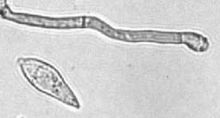| Diaporthomycetidae | |
|---|---|

| |
| Magnaporthe grisea | |
| Scientific classification | |
| Domain: | Eukaryota |
| Kingdom: | Fungi |
| Division: | Ascomycota |
| Class: | Sordariomycetes |
| Subclass: | Diaporthomycetidae Senan., Maharachch. & K.D.Hyde, 2015[1] |
| Orders | |
Diaporthomycetidae is a subclass of sac fungi under the class Sordariomycetes.[2]
The subclass was formed in 2015 for some fungi taxa that were already placed within Sordariomycetidae subclass but that were phylogenetically and morphologically distinct from genera in Sordariomycetidae. Members of Diaporthomycetidae can occur in both aquatic and terrestrial habitats as saprobes (living on decayed dead or waste organic matter), pathogens, or endophytes (within a plant for at least part of its life cycle without causing apparent disease).[3]
In 2017, there were up to 15 orders and 65 families in this subclass.[4] More orders may be confirmed in DNA-based phylogenetic analysis studies in 2021.[5]
- ^ Maharachchikumbura, S.S.N; Hyde, K.D; Jones, E.B.G. et al. 2015. Towards a natural classification and backbone tree for Sordariomycetes. Fungal Diversity. 72:199-301
- ^ Hyde, Kevin D.; Norphanphoun, C.; Maharachchikumbura, S.S.N.; Bhat, D.J.; Jones, E.B.G.; Bundhun, D.; Chen, Y.J.; Bao, D.F.; Boonmee, S.; Calabon, M.S.; Chaiwan, N.; Chethana, K.W.T.; Dai, D.Q.; Dayarathne, M.C.; Devadatha, B.; Dissanayake, A.J.; Dissanayake, L.S.; Doilom, M.; Dong, W.; Fan, X.L.; Goonasekara, I.D.; Hongsanan, S.; Huang, S.K.; Jayawardena, R.S.; Jeewon, R.; Karunarathna, A.; Konta, S.; Kumar, V.; Lin, C.G.; Liu, J.K.; Liu, N.G.; Luangsa-ard, J.; Lumyong, S.; Luo, Z.L.; Marasinghe, D.S.; McKenzie, E.H.C.; Niego, A.G.T.; Niranjan, M.; Perera, R.H.; Phukhamsakda, C.; Rathnayaka, A.R.; Samarakoon, M.C.; Samarakoon, S.M.B.C.; Sarma, V.V.; Senanayake, I.C.; Shang, Q.J.; Stadler, M.; Tibpromma, S.; Wanasinghe, D.N.; Wei, D.P.; Wijayawardene, N.N.; Xiao, Y.P.; Yang, J.; Zeng, X.Y.; Zhang, S.N.; Xiang, M.M. (2020). "Refined families of Sordariomycetes". Mycosphere. 11: 305–1059. doi:10.5943/mycosphere/11/1/7. hdl:10033/622756.
- ^ Chethana, Thilini (10 October 2022). "Diaporthomycetidae - Facesoffungi number: FoF 00594". Faces Of Fungi. Retrieved 14 January 2023.
- ^ Hyde, K.D.; Maharachchikumbura, S.S.; Hongsanan, S.; Samarakoon, M.C.; Lucking, R.; Pem, D.; Harishchandra, D.; Jeewon, R.; Zhao, R.L.; Xu, J.C.; Liu, J.K. (2017). "The ranking of fungi: a tribute to David L. Hawksworth on his 70th birthday". Fungal Divers. 84: 1–23.
- ^ Huang, Shi-Ke; Hyde, Kevin D.; Mapook, Ausana; Maharachchikumbura, Sajeewa S. N.; Bhat, Jayarama D.; McKenzie, Eric H. C.; Jeewon, Rajesh; Wen, Ting-Chi (2021). "Taxonomic studies of some often over-looked Diaporthomycetidae and Sordariomycetidae". Fungal Diversity. 111: 443–572.